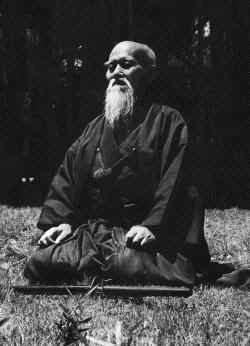|
|||
|
| -Countries |
| -Dictionary |
| -Federations |
| -M.A. Timeline |
| -Number System |
| -Styles |
| -Weapons |
| -Who's Who |
| -Updates |
| -Credits |
| -Stats |
| -Webmaster |
| Morihei Ueshiba
The founder of Aikido,
Morihei Ueshiba, was born on December 14, 1883, to a farming
family in an area of the Wakayama Prefecture now known as Tanabe.
Among five children, he was the only son. From his father Yoroku,
he inherited a samurai's determination and interest in School seemed to bore Morihei as his nervous energy needed a more practical outlet. He took on several jobs, but they too seemed to disillusion him. During a brief stint as a merchant, he finally realized he had an affinity for the martial arts. He greatly enjoyed his study of Jujutsu at the Kito-ryu dojo and Swordsmanship at the Shinkage Ryu training center. But as luck would have it, a severe case of Beri-Beri sent him home, where he later married Itogawa Hatsu. After regaining his health during the Russo-Japanese War period, he decided to enlist in the army. Standing at just under five feet tall, he failed to meet the minimum height requirements. He was so upset that he went immediately to the forests and swung on trees trying desperately to stretch his body out. On his next attempt to enlist, he passed his examination and became an infantryman in 1903. During this time he impressed his superiors so much that this commanding officer recommended him for the National Military Academy, but for various reasons he declined the position and resigned from active duty.
It was during this time in Hokkaido that he met Sokaku Takeda, grandmaster of Daito-ryu Aiki Jutsu. After meeting Takeda and find himself no match for his teacher, Ueshiba seemed to forget everything else and threw himself into training. After about a month, he went back to Shirataki, build a dojo and invited Takeda to live there, which he did. Upon hearing of his father's serious illness, Ueshiba sold off most of his property and left the dojo to Takeda. He would not to return to Hokkaido. On his journey home, he impulsively stopped in Ayabe, headquarters for the new Omoto-kyo religion. Here he met the master of the new religion, Deguchi Onisaburo. After being enthralled with Ayabe and Deguchi, he stayed three additional days and upon returning home, found that he had stayed away too long. His father had passed away. Ueshiba took his father's death very hard. He decided to sell off all his ancestral land and move to Ayabe to study Omoto-kyo. For the next eight years, Ueshiba studied with Deguchi Onisaburo, taught Budo, and headed up the local fire brigade.
Morihei Ueshiba was history's greatest martial artist. Even as an old man of eighty, he could disarm any foe, down any number of attackers, and pin an opponent with a single finger. Although invincible as a warrior, he was above all a man of peace who detested fighting, war, and any kind of violence. His way was Aikido, which can be translated as "The Art of Peace." Morihei Ueshiba is referred to by the practitioners of Aikido as O Sensei, "The Great Teacher". The Art of Peace is an ideal, but it developed in real life
on many fronts. Morihei in his youth served as an infantryman
in the Russo-Japanese War, later battled pirates and bandits
during an adventure in Mongolia, and then, after mastering a
number of martial arts, served as an instructor at japan's elite
military acadamies. Throughout his life, however, Morihei was
sorely troubled by the contention and strife that plagued his
world: his father's battles with corrupt politicans and their
hired goons, the devastation of war, and the brutality of his
country's military leaders. Morihei was on a spiritual quest and was transformed by three visions. The first occurred in 1925, when Morihei was forty-two years old. After defeating a high-ranking swordsman by avoiding all his cuts and thrusts (Morihei was unarmed), Morihei went into his garden. "Suddenly the earth trembled. Golden vapor welled up from the ground and engulfed me. I felt transformed into a golden image, and my body seemed as light as a feather. All at once I understood the nature of creation: the Way of a Warrior is to manifest Divine Love, a spirit that embraces and nurtures all things. Tears of gratitude and joy streamed down my cheeks. I saw the entire earth as my home, and the sun, moon, and stars as my intimate friends. All attachment to material things vanished." The second vision took place in December of 1940. "Around two o'clock in the morning as I was performing ritual purification, I suddenly forgot every martial art technique I ever learned. All of the techniques handed down from my teachers appeared completely anew. Now they were vehicles for the cultivation of life, knowledge, virtue, and good sense, not devices to throw and pin people." The third vision was in 1942, during the worst of the fighting of World War II and in one of the darkest periods of human history. Morihei had a vision of the Great Spirit of Peace, a path that could lead to the elimination of all strife and the reconciliation of humankind. "The Way of the Warrior has been misunderstood as a means to kill and destroy others. Those who seek competition are making a grave mistake. To smash, injure, or destroy is the worst sin a human being can commit. The real Way of a Warrior is to prevent slaughter - it is the Art of Peace, the power of love." Morihei secluded himself in the country and devoted every minute of his life thereafter to refining and spreading Aikido, the Art of Peace. Unlike the authors of old-time warrior classics such as The
Art of War and The
Book of Five Rings, which accept the inevitability of war
and Iwama is considered by many to be the birth place of modern-day Aikido, "the Way of Harmony." Prior to this move, his system had been called Aikijutsu, then Aiki-Budo, still primarily a martial art rather than a spiritual path. From 1942 (when the name Aikido was first formally used) to 1952, Ueshiba consolidated the techniques and perfected the religious philosophy of Aikido.
In early Spring 1969, O Sensei fell ill and told his son Kisshomaru
that "God is calling me...." He was returned to his
home at his request to be near his dojo. On April 15th, his
condition became critical. As his students made their last calls,
he gave his final instructions. "Aikido is for the entired
world. Train not for selfish reasons, but for all people everywhere."
Early on the morning of April 26th, 1969, the 86-year-old O Sensei took his son's hand, smiled and said, "Take care of things" and died. Two months later, Hatsu, his wife of 67 years, followed him. O Sensei's ashes were buried in the family temple in Tanabe. Every year a memorial service is held on April 29th at the Aiki Shrine in Iwama. Although Aikido originated with Morihei in Japan, it was intended to be a gift for all humankind. Some have chosen, or will select in the future, Aikido as their own particular Way, practicing it on the mats and applying it to their daily lives. Many more have been and will be inspired by the universal message of the Art of Peace and its implications for our world.
|

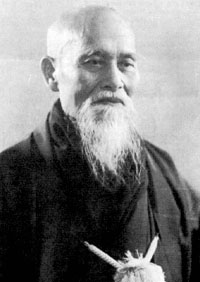
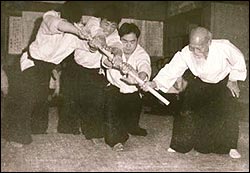 public
affairs, and from his mother an intense interest in religion,
poetry and art. In his early childhood, Morihei was rather weak
and sickly, which led to his preference of staying indoors to
read books instead of playing outside. He loved to listen to
the miraculous legends of the wonder-working saints "En
no Gyoja" and "Kobo Daishi," and was fascinated
by the esoteric Buddhist riturals. Morihei had even considered
becoming a Buddhist priest at one time. To counteract his son's
daydreaming, Yoroki would recount the tales of Morihei's great-grandfather
"Kichiemon," said to be one of the strongest samurai
of his day, and encouraged him to study Sumo wrestling and swimming.
Morihei became stronger and finally realized the necessity of
being strong after his father was attacked and beaten by a gang
of thugs hired by a rival politician.
public
affairs, and from his mother an intense interest in religion,
poetry and art. In his early childhood, Morihei was rather weak
and sickly, which led to his preference of staying indoors to
read books instead of playing outside. He loved to listen to
the miraculous legends of the wonder-working saints "En
no Gyoja" and "Kobo Daishi," and was fascinated
by the esoteric Buddhist riturals. Morihei had even considered
becoming a Buddhist priest at one time. To counteract his son's
daydreaming, Yoroki would recount the tales of Morihei's great-grandfather
"Kichiemon," said to be one of the strongest samurai
of his day, and encouraged him to study Sumo wrestling and swimming.
Morihei became stronger and finally realized the necessity of
being strong after his father was attacked and beaten by a gang
of thugs hired by a rival politician.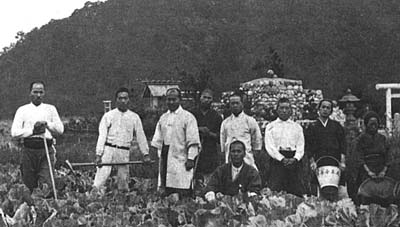
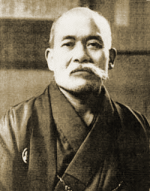 Morihei
returned home to the farm. Having grown strong during his time
in the military, he was now eager to continue physical training.
His father built a dojo on his farm and invited the well-known
Jujutsu instructor Takaki Kiyoichi to tutor him. During this
time, young Ueshiba became stronger and found he possessed great
skills. At the same time he became more interested in political
affairs. In the Spring of 1912, at the age of 29, he and his
family moved into the wilderness of Hokkaido. After a few years
of struggle, the small village started to prosper. Ueshiba had
grown tremendously muscular, to the point that the power he
possessed in his arms became almost legendary.
Morihei
returned home to the farm. Having grown strong during his time
in the military, he was now eager to continue physical training.
His father built a dojo on his farm and invited the well-known
Jujutsu instructor Takaki Kiyoichi to tutor him. During this
time, young Ueshiba became stronger and found he possessed great
skills. At the same time he became more interested in political
affairs. In the Spring of 1912, at the age of 29, he and his
family moved into the wilderness of Hokkaido. After a few years
of struggle, the small village started to prosper. Ueshiba had
grown tremendously muscular, to the point that the power he
possessed in his arms became almost legendary. 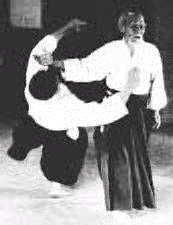 A
pacifist, Deguchi was an advocate of non-violent resistance
and universal disarmament. He was noted to have said, "Armament
and war are the means by which the landlords and capitalists
make their profit, while the poor suffer." It is intriguing
that a man of this nature could become so close to a martial
artist such as Ueshiba. However, it did not take long for Deguchi
to realize that Ueshiba's purpose on earth was " to teach
the real meaning of Budo: an end to all fighting and contention.
"
A
pacifist, Deguchi was an advocate of non-violent resistance
and universal disarmament. He was noted to have said, "Armament
and war are the means by which the landlords and capitalists
make their profit, while the poor suffer." It is intriguing
that a man of this nature could become so close to a martial
artist such as Ueshiba. However, it did not take long for Deguchi
to realize that Ueshiba's purpose on earth was " to teach
the real meaning of Budo: an end to all fighting and contention.
" 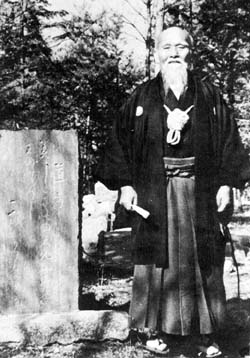
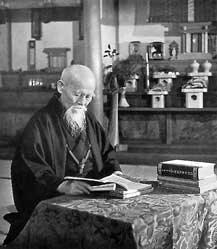
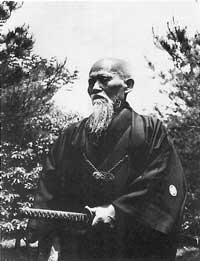 emphasize
cunning strategy as a means to victory, Morihei understood that
continued fighting - with others, with ourselves, and with the
environment - will ruin the earth. "The world will continue
to change dramatically, but fighting and war can destroy us
utterly. What we need now are techniques of harmony, not those
of contention. The Art of Peace is required, not the Art of
War." Morihei taught the Art of Peace as a creative mind-body
discipline, as a practical means of handling aggression, and
as a way of life that fosters fearlessness, wisdom, love, and
friendship. He interpreted the Art of Peace in the broadest
possible sense and believed that its principles of reconciliation,
harmony, cooperation, and empathy could be applied bravely to
all the challenges we face in life - in personal relationships,
as we interact with society, at work and in business, when dealing
with nature. Everyone can be a warrior for peace.
emphasize
cunning strategy as a means to victory, Morihei understood that
continued fighting - with others, with ourselves, and with the
environment - will ruin the earth. "The world will continue
to change dramatically, but fighting and war can destroy us
utterly. What we need now are techniques of harmony, not those
of contention. The Art of Peace is required, not the Art of
War." Morihei taught the Art of Peace as a creative mind-body
discipline, as a practical means of handling aggression, and
as a way of life that fosters fearlessness, wisdom, love, and
friendship. He interpreted the Art of Peace in the broadest
possible sense and believed that its principles of reconciliation,
harmony, cooperation, and empathy could be applied bravely to
all the challenges we face in life - in personal relationships,
as we interact with society, at work and in business, when dealing
with nature. Everyone can be a warrior for peace.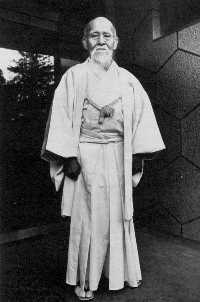 After
the war, Aikido grew rapidly at the Kobukan (now called Hombu
Dojo) under the direction of Kisshomaru Ueshiba. Morihei Ueshiba
had become famous as "O Sensei" or "The Grand
Teacher," the Master of Aikido. He had also received many
decorations from the Japanese government. Right up to the end
of his life, O Sensei refined and improved his "Way",
never losing his dedication for hard training.
After
the war, Aikido grew rapidly at the Kobukan (now called Hombu
Dojo) under the direction of Kisshomaru Ueshiba. Morihei Ueshiba
had become famous as "O Sensei" or "The Grand
Teacher," the Master of Aikido. He had also received many
decorations from the Japanese government. Right up to the end
of his life, O Sensei refined and improved his "Way",
never losing his dedication for hard training. 